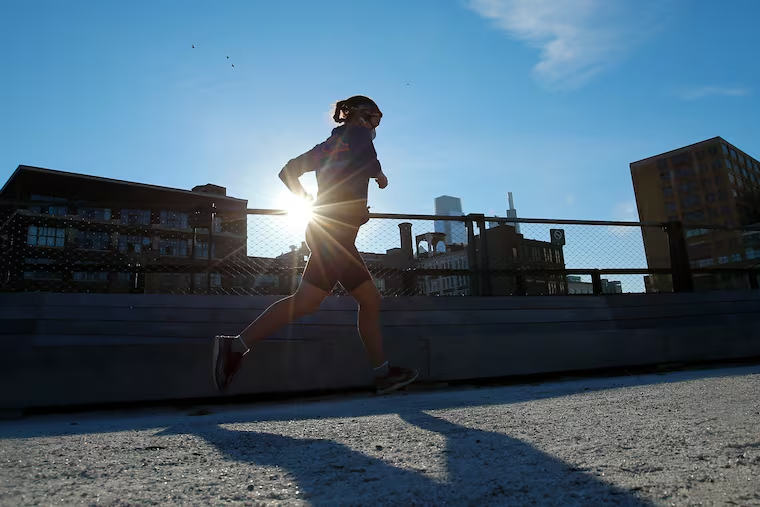How can Philly build green without displacing residents?
Some research suggests that green development causes gentrification. But experts and community advocates say it’s not inevitable.

When Debbie Robinson steps out of her apartment, she loves looking at the trees. “We got all these beautiful trees. Red trees, all these different yellow trees, all these beautiful trees,” Robinson, 59, said of her apartment complex in Grays Ferry.
The trees make her feel better about her health, too. “A lot of people don’t know, trees give off good oxygen. And I love that, because [I’m] on oxygen 24 hours a day, [but] I’ll be going out and stuff because I’ve never been a person to just sit around.”
That greenery goes away once she gets out onto the street, though. “It’s just dead. It’s just dead,” she said, explaining how trees and healthy grasses are hard to find in her area.
Robinson is a member of the environmental justice group Philly Thrive, and wishes that the city or private developers might plant more trees or build parks to bring more greenery to Grays Ferry. But she also knows that green development sometimes comes with a cost.
“The value of housing would go up and people won’t have nowhere to live,” she said. “If I move out of this complex, where am I going to go? I can’t afford that. Me and my husband, we’re living on his disability.”
“So it’s like a catch-22. But we really need it.”
Last month in Philadelphia, it felt like 105 degrees in the shade. With cooler days ahead, it may be easy to forget that the effects of climate change go beyond the rising temperature; environmental pollutants are shortening people’s lives in Philadelphia and water is flooding their neighborhoods.
And as tends to be the case with many of the problems affecting the city, low-income communities of color often experience those affects most acutely. North and West Philly are measurably hotter than the rest of the city.
But while climate change is a global problem that is mostly driven by large corporations and wealthy individuals, Philadelphia can still build climate-supporting improvements that make the environment more tolerable for its people.
These projects can be both large and small, from the construction of sprawling parks like Philly’s proposed Rail Park, to a row of trees along a street, or the creation of new bike lanes.
Don’t forget about displacement
Building new green infrastructure may seem like an entirely beneficial move for Philadelphians, especially those who live in the hottest and most flood-prone areas. But community advocates and academics alike are warning against a rush to build new parks and plant trees without seriously thinking about one potential consequence: displacement.
“Folks are absolutely thinking about gentrification. I think when community members ... hear about any kind of development, they think it’s for someone else,” said Jerome Shabazz, the executive director of the Overbrook Environmental Education Center, and an original member of the city’s Environmental Justice Advisory Commission. “That is an apathy that is not ill placed. It’s the tradition.”
In a 2020 study of the city’s new public green spaces, Temple University’s Hamil Pearsall and Jillian K. Eller found that “public green spaces may anchor gentrification processes. Additionally, new spaces in wealthy neighborhoods were more publicly accessible than parks in gentrifying neighborhoods.”
“It should not just be for others. It should be for all.”
Research confirmed that the city’s most vulnerable people feel these negative greening affects most. When certain kinds of green infrastructure are built in already gentrifying neighborhoods, it can lead to further displacement and, according to a Temple University study, forces Black and Latinx residents to move to areas that are hotter and have less climate protection.
“Maybe people appreciate having a new park or more trees ... but they’re concerned about what the broader impacts [are] and what it might mean for their community,” Pearsall, an associate professor of geography and urban studies at Temple, told The Inquirer.
Urban greening, Shabazz said, should be a valued-added proposition to every community member.“It should not just be for others. It should be for all. And we have to find a way to do that, particularly [for] the most vulnerable because they have the least amount of advocacy around these issues.”
» READ MORE: Philly to hire its first city forester, and plant thousands of trees over the next decade
Reflecting the communities and neighborhoods
Shabazz believes that if the city and developers considered the impacts of their greening in planning stages, it would help prevent gentrification that might come years later. For instance, green projects could be paired with local hiring mandates or housing stabilization policies.
“The only thing that precedes our actions are our intentions,” he said. “Displacement is a part of your planning process. The question is, are you driving and pushing for that, or are you not?”
But even while the city, environmentalists, and developers consider their impact internally, it’s critical for them to work more closely with community groups as they consider future greening projects, too.
Shabazz thinks the city and environmentalists like him can do a better job of educating residents about the effects of today’s environment on their health and why green development is necessary. And both he and Pearsall emphasized the need for more communication with community members overall, so that greening meets the needs of people currently living in these project areas and ultimately helps prevent displacement.
“That whole concept of community engagement is really important, but not just engagement as allowing people to weigh in, but to really be an important part of the decision-making process,” Pearsall said.
“[It’s] making sure people feel like the green spaces that are being developed are really for them, something that reflects their community and who they are and what they would like to have in their neighborhood.”